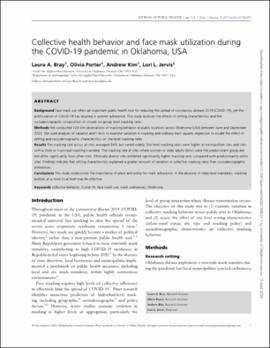| dc.contributor.author | Bray, Laura A. | |
| dc.contributor.author | Porter, Olivia | |
| dc.contributor.author | Kim, Andrew | |
| dc.contributor.author | Jervis, Lori L. | |
| dc.date.accessioned | 2022-04-13T16:25:53Z | |
| dc.date.available | 2022-04-13T16:25:53Z | |
| dc.date.issued | 2020-04-04 | |
| dc.identifier.citation | Laura A Bray, Olivia Porter, Andrew Kim, Lori L Jervis, Collective health behavior and face mask utilization during the COVID-19 pandemic in Oklahoma, USA, Journal of Public Health, 2022;, fdac007, https://doi.org/10.1093/pubmed/fdac007 | en_US |
| dc.identifier.uri | https://hdl.handle.net/11244/335235 | |
| dc.description.abstract | Background | en_US |
| dc.description.abstract | Face mask use offers an important public health tool for reducing the spread of coronavirus disease 2019 (COVID-19), yet the politicization of COVID-19 has resulted in uneven adherence. This study assesses the effects of setting characteristics and the sociodemographic composition of crowds on group-level masking rates. | |
| dc.description.abstract | Methods | |
| dc.description.abstract | We conducted 123 site observations of masking behavior at public locations across Oklahoma (USA) between June and September 2020. We used analyses of variance and t-tests to examine variation in masking and ordinary least squares regression to model the effect of setting and sociodemographic characteristics on site-level masking rates. | |
| dc.description.abstract | Results | |
| dc.description.abstract | The masking rate across all sites averaged 34% but varied widely. Site-level masking rates were higher at metropolitan sites and sites with a store or municipal masking mandate. The masking rate at sites where women or older adults (60+) were the predominant group did not differ significantly from other sites. Ethnically diverse sites exhibited significantly higher masking rates compared with predominantly white sites. Findings indicate that setting characteristics explained a greater amount of variation in collective masking rates than sociodemographic differences. | |
| dc.description.abstract | Conclusions | |
| dc.description.abstract | This study underscores the importance of place and policy for mask adherence. In the absence of state-level mandates, masking policies at a more local level may be effective. | |
| dc.description.sponsorship | This work was supported by a University of Oklahoma Vice President for Research and Partnerships COVID-19 Rapid Response Seed Grant. | en_US |
| dc.language | en_US | en_US |
| dc.rights | Attribution 4.0 International | * |
| dc.rights.uri | https://creativecommons.org/licenses/by/4.0/ | * |
| dc.subject | collective behavior | en_US |
| dc.subject | Covid-19 | en_US |
| dc.subject | face mask use | en_US |
| dc.subject | mask ordinances | en_US |
| dc.subject | Oklahoma | en_US |
| dc.title | Collective health behavior and face mask utilization during the COVID-19 pandemic in Oklahoma, USA | en_US |
| dc.type | Article | en_US |
| dc.description.peerreview | Yes | en_US |
| dc.identifier.doi | 10.1093/pubmed/fdac007 | en_US |
| ou.group | Other | en_US |

